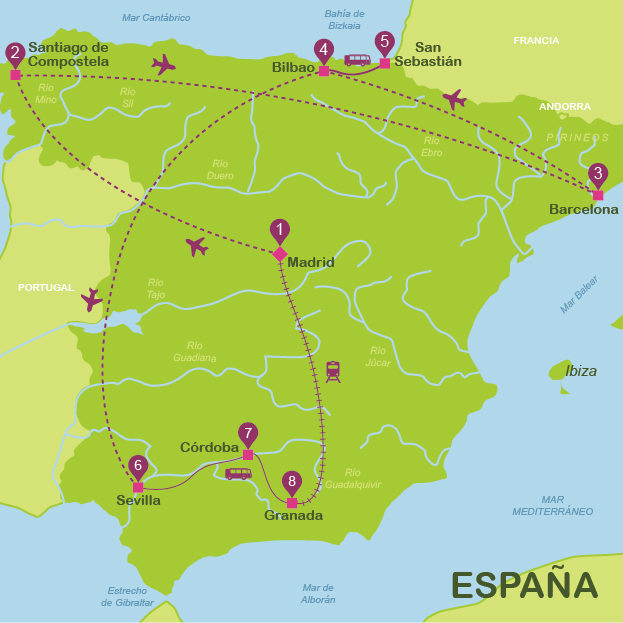This is the name given to the area that includes Atocha, Paseo del Prado and Paseo de Recoletos due to the close proximity to each other of three of the most important museums in the city: the Prado Museum, the Reina Sofía Museum and the Thyssen-Bornemisza Museum. A visit to the Prado is a must. There you will find a rich concentration of works by European artists from the 16th to the 19th centuries. The Reina Sofia Museum focuses on contemporary Spanish art from the end of the 19th century to the present. The Thyssen Museum contains both classical and contemporary art. It's the largest private art collection in the world and perhaps the most innovative of the three. We recommend visiting all three, but if you don't have the time or desire to visit them all, the order of priority is the following:
- Brief description: One of the most important art galleries in the world, particularly rich in paintings by European masters from the 16th to the 19th centuries. It boasts the best collection in the world of paintings by Velázquez, Goya, Titian and Rubens, and good representations of other important artists such as El Greco, Murillo, José de Ribera, Zurbarán, Rafael, Veronese, Tintoretto, Van Dyck and Bosch. Due to space limitations, the museum only exhibits 900 of the 7,800 paintings in its holdings. For this reason it is known as the "greatest concentration of masterpieces per square metre" on the planet. Given how big the museum is, we tell you where to find the most important paintings.
- Ground floor: Start in Gallery 56A with Bosch's futuristic "Garden of Earthly Delights", even more mind-bending when you consider it was painted in the 16th century. Move on from there to Galleries 64 and 65, where you'll find "The Second of May" and "The Third of May" by Francisco Goya.
- First floor: In Gallery 36 are Goya's "The Naked Maja" and "The Dressed Maja". Next come the paintings by Velazquez we recommend viewing: in Gallery 15A are "Las Hiladeras" (The Spinners") and "Mercury and Argus". In Gallery 15 is "Dwarves and Buffoons", and in Gallery 12 you'll find the famous painting "Las Meninas", which is very interesting since it is also a self-portrait (the painter can be seen painting Felipe IV and Mariana de Austria, whose images are reflected in the mirror). In Gallery 27, directly in front of "Las Meninas", is the famous "The Surrender of Breda". In Gallery 10 is the amusing painting "Los Borrachos" (The Drunks). In Gallery 10A is El Greco's "El caballero de la mano en el pecho" (The Knight with His Hand on His Breast). In Gallery 9B are some interesting paintings by Van Dyck. In Gallery 42 is Titian's "Bacchanal of the Andrians".
- Second floor: It's worth going upstairs and visiting Gallery 92, where you'll find "El cacharerro" (The Crockery Seller), a beautiful genre painting by Goya.
- Cost: 14€.
- Length of visit: 2-3hrs.
- Hours: Monday-Saturday: 10:00am to 8:00pm. Sundays and holidays:10.00am to 7.00pm.
- How to get there: Metro Banco de España (L2) and Atocha (L1).
- Brief description: Vast collection of modern art with a good representation of Dalí, Miró and Picasso (here you'll find Picasso's famous "Guernica", a painting depicting the terror induced by the bombardment of the city of Guernica during the Spanish Civil War).
- Cost: 8€.
- Length of visit: 2 hours.
- Hours: from Monday to Saturday: 10:00 to 21:00; Sunday: 10:00 to 14.30. Closed Tuesdays.
- How to get there: Metro Atocha (L1) and Lavapiés (L3).
- Brief description: Complements the previous two museums with numerous foreign artists absent from the Spanish museum circuit, ranging from the Gothic period (Duccio, Jan van Eyck) to pop art and the eighties (Tom Wesselman, Lucian Freud).
- Cost: 10€ permanent collection, 8-110€ for temporary exhibits.
- Length of visit: 2 hours.
- Hours: Tuesday-Sunday: 10:00 to 19:00; Closed Mondays.
- How to get there: Metro Banco de España (L2).

